The Final Update: Flash Video Performance on Ion
by Anand Lal Shimpi on May 26, 2009 12:00 AM EST- Posted in
- Anand
It must be because this thing is so darn tiny that I don’t mind testing it all the time, but today’s short update marks the third follow up to our original Zotac Ion review.
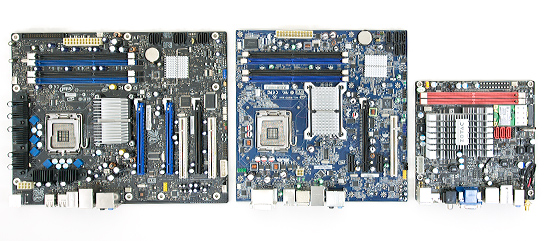
The original article crowned the Zotac Ion as the best Atom based mini-ITX board I’d ever encountered. It wasn’t a hard feat to accomplish, after all, there are only two other Atom based mini-ITX boards on the market and neither one offers a real GPU.
The first follow up addressed questions that readers of the first article had. Looking into things like the overclocking potential of the platform and additional detail on power consumption.
The second follow up addressed the Zotac’s wake-on-USB support, or lack thereof. Today I’m publishing what I hope to be my last update on this hardware until I get a new revision, but as always if there’s something you’d like to know don’t hesitate to ask.
Wake-on-USB Support: The Explanation
Zotac has been very proactive with getting me updates on its motherboard, I have their excellent North American PR rep to thank for that :)
As I mentioned in the last update, the Zotac Ion board won’t wake up from a S3 sleep state after activity on a USB device (e.g. moving your mouse, hitting a button on a media center remote, etc...). Zotac listed the problem as being a hardware issue that won’t get fixed until the next revision of the motherboard; early adopters are out of luck. I now have an explanation as to why.

The USB ports on the current version of the motherboard (PCB version 00) are powered by the 5V rail from the motherboard. When the motherboard goes into a S3 sleep state, 5V power is shut off, so the USB ports are completely off.
In the next revision of the motherboard (PCB version 01) standby power will be connected to the USB ports, allowing the ports to still be alive when the board is in S3. The manual shows you where you can identify what PCB revision you have.
I’m guessing externally powered USB hubs are able to pull the system out of sleep since the USB device is still on, but a USB device connected directly to the motherboard will be completely powerless in S3. The explanation makes sense to me; if you were wondering, now you know.
Flash Video Playback on the Ion: Delving Deeper
I personally get most of my “TV” from Hulu so I completely understand the desire to know how well Intel’s Atom and the Ion platform in general perform when playing back Flash Video.
A few readers requested that I look deeper into the Ion’s FLV performance, especially when the Ion was overclocked. I had some spare time today so I did just that.
In my first follow up article I found that the Ion could play, without a problem, standard sized 360p and 480p Hulu videos. Attempting to increase the video window size to full screen yielded a highly unplayable video. I wanted to investigate further.
I used the latest version of Adobe’s Flash 10 player as well as Internet Explorer 8 under Windows Vista Ultimate 32-bit. With a desktop resolution of 1360 x 768 I tried five tests:
1) 360p, video window popped out and maximized to desktop resolution
2) 360p in Hulu’s full screen mode
3) 480p, video window popped out and maximized to desktop resolution
4) 480p in Hulu’s full screen mode
5) 720p playing a Hulu HD video
I ran the five tests in two configurations; first with the Atom 330 at its default 1.60GHz clock speed and second with the Atom overclocked to 1.92GHz (the highest stable frequency I could overclock the Atom to).
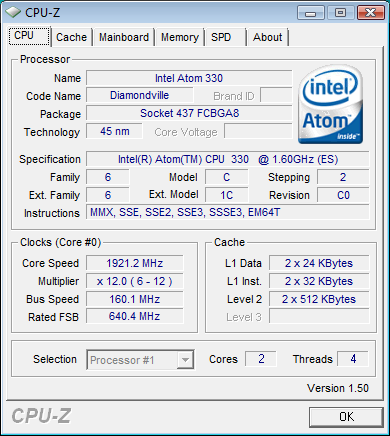
My impressions are in the table below:
| Scenario | Atom 330 @ 1.6GHz | Atom 330 @ 1.92GHz |
| 360p, maximized window | Some tearing, lower frame rate than default window, perhaps slightly smoother with hardware acceleration turned off? | Totally watchable, definitely lower frame rate but watchable |
| 360p, full screen | Totally unacceptable, not really higher CPU utilization than with a maximized window, but too choppy - distracting | Passable, not perfect but it can work if you can ignore some of the choppiness |
| 480p, maximized window | Slightly lower frame rate than the 360p test, but better picture quality so this may be a better option for some. Still annoying to watch due to lower frame rate. | Improved, I think passible. |
| 480p, full screen | Lots of tearing, somewhat more bearable than 360p full screen thanks to improved picture quality. I still prefer maximized window for higher frame rate. | Still choppy. |
| 720p HD | Completely unwatchable, CPU utilization > 90% | Still choppy but a bit better, painful but technically watchable |
While hardware acceleration was enabled in the Adobe Flash Player 10 settings, I can’t say that I noticed a performance difference with it enabled or disabled. I’m not really sure what it’s doing but it definitely didn’t help keep my framerate smooth when upscaling video.

CPU utilization was around 64% when watching a 360p stream in a maximized window
The only situation I would consider 360p full screen Hulu to be passable is when the system was overclocked to 1.92GHz. You’re far better off maximizing your browser window and dealing with the application border than running in Hulu’s seamless full screen mode.
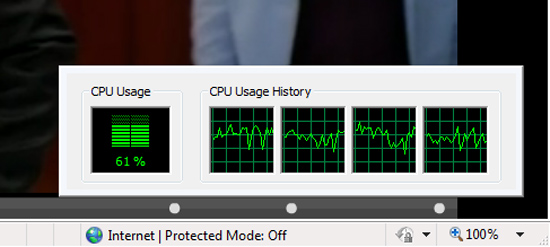
Overclocking the Atom dropped it to 61%, a small difference but noticeable
I will note that Hulu has difficulty playing in full screen on much faster systems as well, so I’m not sure we can really blame the Atom or Ion for its performance limitations here. It appears that video scaling under Flash is just not very efficient.
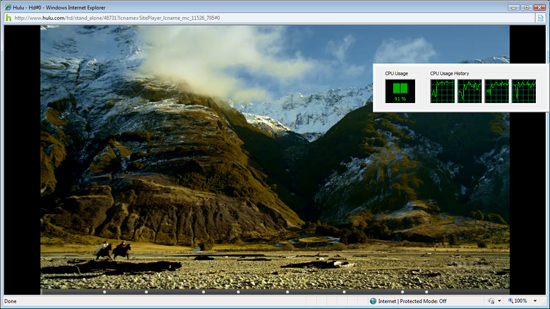
Hulu HD was basically unwatchable thanks to a > 90% CPU utilization
The HD stream is unplayable at stock frequencies but not because of scaling issues, since there's actually much less scaling being done from 720p to 1360 x 768. The HD stream falls victim to the Atom's limited CPU power, which overclocking helps overcome. I do still think that HD Hulu playback is too much for even an Atom 330 unfortunately.
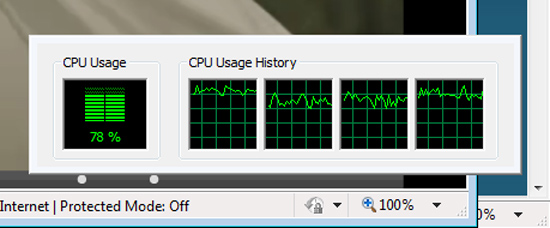
Overclocked, even HD hulu saw a benefit as CPU utilization dropped to below 80%
Overall the overclocking helped, but don’t expect any miracles. Be happy with smaller Hulu window sizes or be doomed to feel unfulfilled it seems. If NVIDIA wants a good case for CUDA, give us smooth FLV playback at any resolution and I'll be happy :)
With that said and done, it’s back to CPUs and SSDs for me.










56 Comments
View All Comments
mschira - Wednesday, May 27, 2009 - link
Totally. I have an Asus EEE 1000, and typically I have the machine in the max performance mode (super hybrid engine) - I think 1.8Ghz.Web browsing using firefox was painfull at times, when more than one tab open and the web site had a lot of flash
Typically the flash is nothing but advertising stuff - so they drain your battery for annoying you. Brilliant.
So I got the flash blocker add on. What a relief!
Not only does all the annoyance disappear, but also the battery lasts longer, many tabs work fine all good.
M.
nubie - Thursday, May 28, 2009 - link
I agree on that flashblock, the last few Flash updates (past year or two) have been so badly optimized it grinds even 3ghz machines to a halt.I consider flashblock a necessity, it is installed right after FF on every system I set up.
Blame Adobe, they need to get Flash fixed, there is no call for this kind of poor performance (delivering simple content that consoles 2 generations ago could deliver, while grinding new PC's to a halt.)
sprockkets - Wednesday, May 27, 2009 - link
Zotac should just do what everyone else does: Put a jumper to enable or disable 5V support for USB. But, then again, real estate on those boards is quite a premium.Seeing as how Newegg is out of stock already, getting one should be easy.
But hey, Anand, is Zotac fixing this on the LGA board too?
strikeback03 - Wednesday, May 27, 2009 - link
I've built several computers for work, and the only Motherboard I have seen one of those jumpers on is an old nForce4 DFI board.Sunraycer - Wednesday, May 27, 2009 - link
I'm not 100% sure, but I think that Flash Video on Hulu is using the VP6 CODEC? What about the stuff from ABC and FOX .com that use Move Networks's On2 VP7 CODEC, think we'd expect the same performance? (Note I don't think the Move Player will run in Chrome yet.)
I've got the Intel board with the Atom 330 running as an HTPC. My resolution is set 1360x768 to my TV. When running in full screen it stutters a bit when it starts and then once in a while. However, I'm running my OS (XP) on an old SSD (OCZ Core2). I'm not sure if that plays into it or not...
kuli - Wednesday, May 27, 2009 - link
So I too, have been playing around with an atom PC. Albeit, with one of the intel-based N330 mobo's.I experienced frame droppage on hulu full screen as well. However, I found that if I dropped the resolution to 800 x 600, it was 100% watchable. I also noticed that it didn't seem to be very well multi threaded, as the processor usage of only 2 of the 4 logical cores went up significantly while watching video. Since Hulu is 480p, dropped resolution on the monitor will not affect the quality of your video stream, although it's really annoying to have to switch resolutions just to watch television. I can only assume that the scaling of the video must be being done entirely in software, and in an extremely inefficient method of doing so. If I can play a full 1080p movie without the aid of nvidia GPU, there is no reason why I shouldn't be able to play lowly 360 or 480p streaming content in full screen.
TA152H - Wednesday, May 27, 2009 - link
Why don't they add a PS/2 mouse port, instead of wiring the USB to standby power? The PS/2 mouse port is more efficient on CPU cycles, and on the Atom, that's important. There aren't too many other devices you'd connect to USB that you'd use to wake up a computer, so it's a good idea. The PS/2 port is probably the oldest part of the PC still around. AT-Bus, and Microchannel are gone, processors have all changed, power supplies are different, cases are different, parallel and serial ports are long gone. The last vestige of the best computer line ever made, the PS/2, is the little ports. I guess the 3.5 floppy disk could be too, but others used that before IBM did with the PS/2.I still remember the logo from 22 years ago ...
How're you going to do it? PS/2 it!
They were wonderful machines.
FaaR - Thursday, May 28, 2009 - link
Wut?Where do you even FIND a PS/2 mouse today, and how many cycles exactly do you think it'll save you? Is it even going to be measureable, even on a stinker of a CPU like the atom (performance-wise anyway)? I seriously doubt that.
I have a PS/2 mouse tucked away in my closet, a Logitech Mouseman+, kept for nostalgic reasons because it's the best damn old-style ball mouse I ever used. Got a mouse wheel, 4th thumb button and everything. But it's more than ten years old now. Nobody makes PS/2 mice anymore. Why bother? Let PS/2 die, it's old crap. We don't need dedicated ports for a single type of device anymore.
mindless1 - Thursday, May 28, 2009 - link
In normal everyday use most people would find it impossible to accurately guess whether their mouse was hooked up to PS2 or USB. That makes it anything but crap.Get rid of a port only when something better replaces it. USB does not replace it because the board can have BOTH. USB suppliments it.
As for your idea about the old Logitech Mouseman, it's invalid. Plenty of mice have came out since then that were dual port capable, with no good reason to plug them into USB for most people unless they have an illogical bias.
More importantly there are support issues. If someone has a lot of USB peripherals you don't necessarily want them all powered by a tiny PSU's 5VSB rail, so you either make it harder for the user to figure out which ports remain powered, put jumpers on the board to switch each port pair (which I felt was the best solution but they didn't) but that also poses the possibility someone will try to power a lot of devices off a dinky PSU's 5VSB rail, or provide a PS2 port so IF someone wants to use it they can.
If they don't want to use it, guess what? Most people do not use every single port, slot, and connector on a system already. That you personally wouldn't use it is not a good reason to deprive someone else from having it.
sprockkets - Wednesday, May 27, 2009 - link
It's considered legacy. The only reason why some boards still have a keyboard port is because the BIOS is iffy when using a USB keyboard. Not impossible, but just iffy.